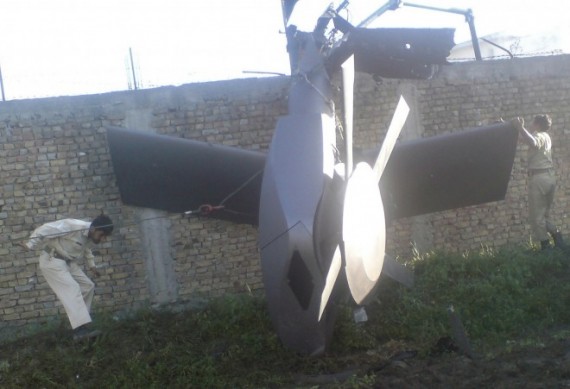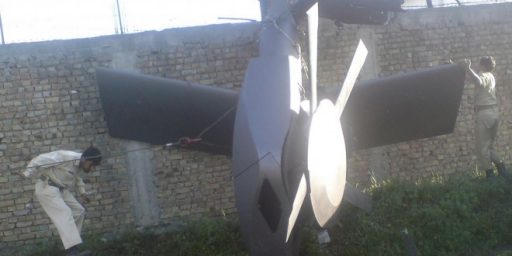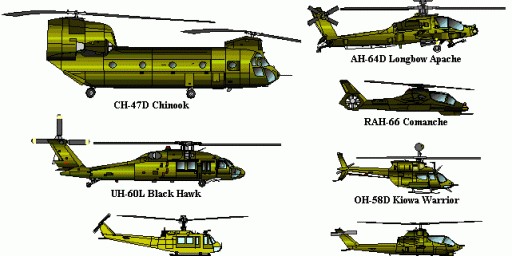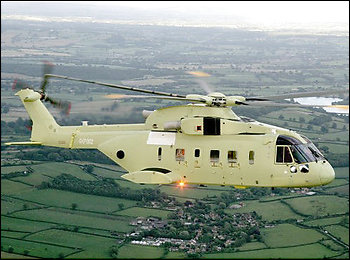Stealth Blackhawk Helicopter Used in Osama Raid
There has been some buzz on the national security backchannels that a heretofore secret "stealth" helicopter was used in the SEAL raid on Osama bin Laden's Pakistan hideout.
There has been some buzz on the national security backchannels that a heretofore secret “stealth” helicopter was used in the SEAL raid on Osama bin Laden’s Pakistan hideout.
The always reliable Daily Mail (“Did U.S. forces use secret stealth helicopters in bin Laden raid?“):
They managed to penetrate Pakistani airspace, hover for 40 minutes, and flee undetected towards Afghanistan until the very last minute.
And now, pictures of the wrecked helicopter that crashed in Osama bin Laden’s compound may shed new light on how Navy SEAL raiders snuck into Abbottabad without alerting Pakistani forces – by using secret ‘stealth’ helicopters. Pictures of the downed chopper’s heavily damaged tail section bear a striking resemblance to the smooth angular design of other stealth aircraft and have left aviation experts struggling to identify the unknown machine.
The pictures have left aviation experts scratching their heads, with several concluding it must be a new, as yet unknown helicopter design.Bill Sweetman, editor of Aviation Week said the pictures show a ‘stealth-configuration’ on the wrecked rotor housing. He said: ‘Well, now we know why all of us had trouble ID’ing the helicopter that crashed, or was brought down, in the Osama raid. ‘It was a secretly developed stealth helicopter, probably a highly modified version of an H-60 Blackhawk.’
Citing pictures shown on MailOnline, he added: ‘Photos show that the helicopter’s tail features stealth-configured shapes on the boom and tip fairings, swept stabilizers and a ‘dishpan’ cover over a non-standard five-or-six-blade tail rotor.’ The willingness to compromise this technology shows the importance of the mission in the eyes of US commanders – and what we’re seeing here also explains why Pakistani defences didn’t see the first wave (at least) coming in. ‘No wonder the team tried to destroy it.’
Sean Naylor of the Army Times explains (“Mission helo was secret stealth Black Hawk“):
The helicopters that flew the Navy SEALs on the mission to kill Osama bin Laden were a radar-evading variant of the special operations MH-60 Black Hawk, according to a retired special operations aviator.
The helicopter’s low-observable technology is similar to that of the F-117 Stealth Fighter the retired special operations aviator said. “It really didn’t look like a traditional Black Hawk,” he said. It had “hard edges, sort of like an … F-117, you know how they have those distinctive edges and angles — that’s what they had on this one.”
In addition, “in order to keep the radar cross-section down, you have to do something to treat the windshield,” he said. If a special coating was applied to the windshield it is “very plausible” that would make the helicopter more difficult to fly for pilots wearing night-vision goggles, he said. The helicopters carrying the SEALs arrived over the bin Laden compound at about 1 a.m. Monday local time. One crash-landed in the courtyard and was so badly damaged it was unable to take off again.
That crash landing might have been caused by a phenomenon known as “settling with power,” which occurs when a helicopter descends too quickly because its rotors cannot get the lift required from the turbulent air of their own downwash. “It’s hard to settle with power in a Black Hawk, but then again, if they were using one of these [low-observable helicopters], working at max gross weight, it’s certainly plausible that they could have because they would have been flying so heavy,” the retired special operations aviator said, noting that low-observable modifications added “several hundred pounds” to the weight of the MH-60, which already weighs about 500 to 1000 pounds more than a regular UH-60 Black Hawk.
The special operations troops on the bin Laden mission destroyed the stricken aircraft — most likely using thermite grenades — but the resultant fire left the helicopter’s tail boom, tail rotor assembly and horizontal stabilizers intact in the compound’s courtyard.
Photographs of the wreckage taken the next day raced around the Internet, creating a firestorm of speculation among military aviation enthusiasts because the tail of the helicopter did not resemble any officially acknowledged U.S. military airframe.
This was to be expected, the retired special operations aviator said. “Certain parts of the fuselage, the nose and the tail had these various almost like snap-on parts to them that gave it the very unique appearance,” he said. He and another source referred to the disc-shaped device that is seen covering the tail rotor in the photographs as a “hubcap.”
If the radar-evading technology worked, it “would be a true statement” to say that the use of the low-observable Black Hawks was evidence that the United States gave Pakistani authorities no advance warning of the mission, the retired special operations aviator added.
The low-observable program started with AH-6 Little Bird special operations attack helicopters in the 1980s, said the aviator. During the 1990s U.S. Special Operations Command worked with the Lockheed-Martin Skunk Works division, which also designed the F-117, to refine the radar-evading technology and apply it to the 160th Special Operations Aviation Regiment’s MH-60s, he said. USSOCOM awarded a contract to Boeing to modify several MH-60s to the low-observable design “in the ’99 to 2000 timeframe,” he said.
Danger Room‘s David Axe weighs in:
Aviation specialists are picking apart pixel-by-pixel the dozen-or-so photos of the copter that have appeared online. They’re assembling digital mock-ups of the aircraft and comparing them to lost stealth designs of the 1980s and ’90s. Speculation abounds, and so far no one from the government is commenting. But depending on what the copter turns out to be, it could shed new light on everything from the abilities of U.S. commandos to the relationship between the United States and Pakistan.
Opinions about the copter seem to fall into three basic camps. The most-cautious observers believe the wreckage is from a conventional chopper that got so badly mangled during the crash that it became unrecognizable. In the center, there are those who think the helicopter is an Army MH-60 Blackhawk tweaked to make it quieter and more stealthy. On the fringes, the true believers are talking about a brand-new, radar-evading helicopter design.
Considering the proliferation of bewildering photos from the crash site, the conservative viewpoint seems unlikely. Equally, the notion of a brand-new “black” helicopter seems far-fetched, especially considering the Army’s long history of heavily modifying existing rotorcraft for secret missions.
That leaves an upgraded, stealth-optimized MH-60 as the most likely candidate — a conclusion that jibes with CIA director Leon Panetta’s assertion Tuesday that the 25-man strike team was “carried in two Blackhawk helicopters that went in.”
Given that military helo pilots are trained to fly nap-of-the-earth and thus below radar, I was dubious about the need for such a thing as stealth technology in this application. But it may make more sense in the context of avoiding detection by the Pakistanis. Of course, even stealthiness doesn’t preclude visual ID, since we have some unsuspecting guy live-tweeting the raid.
Aviation Week‘s Bill Sweetman (“Stealth Helos Used In Osama Raid“) clears up my confusion on what “stealth” means in this context:
Stealth helicopter technology in itself is not new and was applied extensively to the RAH-66 Comanche. Priorities are usually different versus fixed-wing aircraft. Reducing noise and making it less conspicuous is the first job (more main and tail blades reduce the classic whop-whop signature).
Noise can also be reduced by aerodynamic modifications and flight control changes that make it possible to slow the rotor down, particularly in forward flight below maximum speed. Infra-red reduction measures are crucial — the Comanche had an elaborate system of exhaust ducts and fresh-air mixers in its tailboom.
Radar cross-section reduction is also possible – you can’t make a helo as radar-stealthy as a fixed-wing airplane, because of all its moving parts, but on the other hand it is generally operating at low altitude in ground clutter, and is not an easy target. Reducing RCS also makes jamming more effective, whether from the aircraft itself or from a standoff jammer.
So, this is “stealth” in an infantry sense radar than in the manner of the “stealth” fighters and bombers developed in the 1980s to evade electronic detection.






It’s obviously Airwolf.
so how do you get 25 men in on two helo’s, crash one, then get 25 men plus all the computers and don’t forget Osama’s body out on only one helo???? Very interesting.
Dave,
There were spare helos – there always are. I would guess 4 total.
That tail doesn’t belong to any Blackhawk.
Dave,
There were two helicopters in support above. One landed for transport after the other was destroyed.
Hawkdriver32,
The tail is heavily modified, along with many other parts of the aircraft. Read the articles.
Blue Thunder, with the benefit of being able to peep on women who work out naked by their plate glass windows. But only if you’re a cop.
Boyd : I was the happiest boy ever when I got the blue thunder helo toy as a kid. The sucker was large and exceedingly powerful in my assaults on the evil barbie compounds…
Were the barbies exercising in the nude, by any chance? Not that I’m fixated or anything.
Looks like a standard H-60 Black Hawk tail rotor with a cover over the rotor hub and control tubes.
If it is some sort of high tech stealth copter, then we shouldn’t be so reckless. There’s a lot of other nations who would love to get their hands on stealth tech. We shouldn’t have left the Pakistani to clean up after us, considering the close relationship between Pakistan and China. We wouldn’t want that kind of technology falling into the wrong hands. US military should have sent in their own cleanup crew after the raid, I don’t see a lot of reasons not to.
No but some of them sure where scheming in the nude. Luckily my plush Fonzie is a capable pilot and driver!
good chance for pakistan to copy this technology, osama death gift